
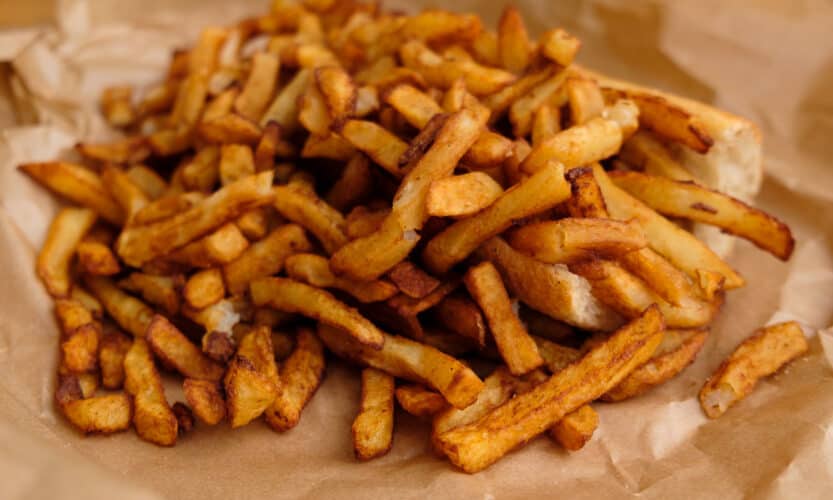
The British have fish and chips, the Spanish have patatas bravas, and the Canadians have poutine. But the humble potato reaches its pinnacle in Belgian fries — with their golden shine, unforgettable crunch, and perfectly hearty aftertaste.
Belgium, the country where bouts of nationalism are scarce, is forgettable in many regards. We don’t have the rolling hills of Switzerland, the flashy neon-sign culture of Japan, or the waves of Hawaii that every surfer hopes to catch before they die. But what we do have is food and drinks that make many a traveller’s mouth water.
Consider Belgian fries for a minute. The golden fried potato sticks are incredibly deep-rooted in the Belgian gastronomic legacy. So deep-rooted, in fact, that there’s a national movement to have our fry culture recognised by UNESCO as Intangible Cultural Heritage.
At the helm of this movement is Bernard Lefèvre, President of Navefri-Unafri (the National Association of Fryers).
“We don’t aspire for this international recognition to attract millions of travellers to Belgium,” says Lefèvre. “But the only way to keep our national fry culture alive is to ensure that those who experience that culture can be proud of it.”
When we broke the world record for the longest time without a government in 2011, fries were virtually the only thing keeping the country together. And now, we’re reclaiming the legacy of the so-called French fries.
Paul Ilegems, a retired professor of art history and curator of the world’s first Fry Museum in Bruges, acknowledges that the origin of the fry is unclear in his book ‘Encyclopedie van de friet’ — with the two strongest voices coming from French and Belgian fry fiends.
The French claim that the first fry was sold in the 1780s, on the Parisian Pont Neuf. Culinary historian Karen Hess, however, posited that the French at the time considered potato slices more elegant than potato sticks. This makes it unlikely that the 18th-century Parisian fry looked anything like our current fries.
In Belgium, two popular stories offer a possible origin of the fry: that of Jo Gérard and that of Jean Frédéric Krieger.
Jo Gérard was a Belgian historian who claimed that Walloon peasants invented fries by accident in the 17th century. A manuscript by one of his ancestors supposedly described how thick potato sticks were fried as a substitute for fried small fish when the river Meuse was frozen. His forefather never published this manuscript, however, and historians agree that the potato didn’t reach southern Belgium until 1709. Theory debunked, in other words.
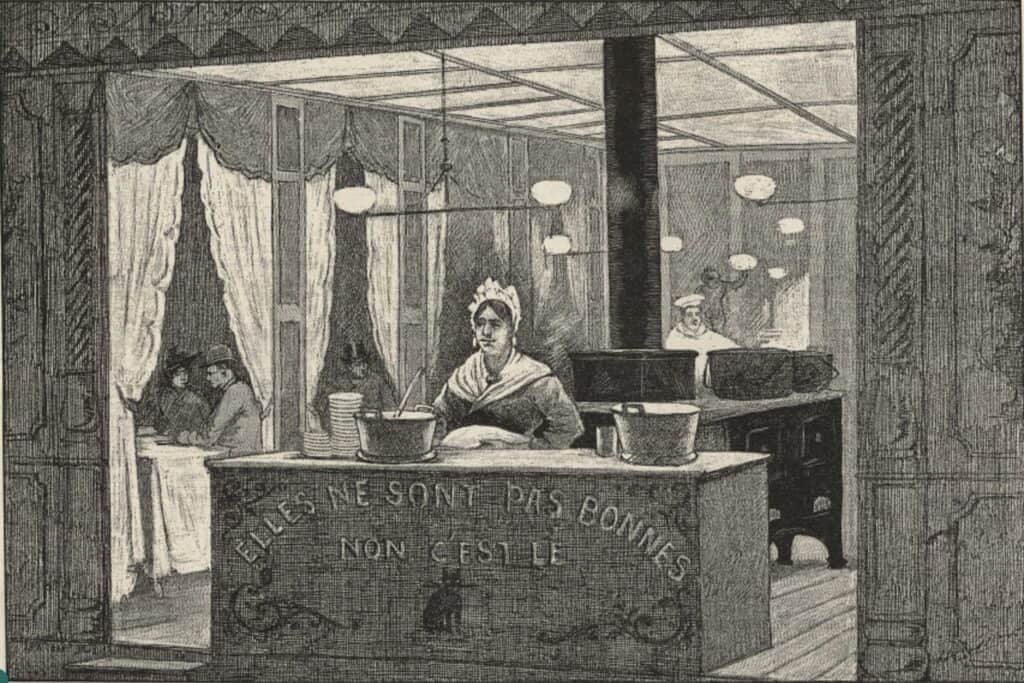
A more plausible story is that of Jean Frédéric Krieger and Renée Florence Vilain — better known as Monsieur and Madame Fritz.
Krieger was a Belgian-Bavarian carnival vendor who started operating several fry shops under the Fritz brand in the 1830s. After his death, Vilain married a competing vendor and continued the family business as Madame Fritz until her demise in 1889.
But while the Fritzes may have popularised the fried potato in Belgium, they didn’t invent it. According to Ilegems, that honour goes to Teresa of Ávila.
As early as the 1570s, the Spanish Carmelite nun was already growing potatoes in the convent garden. The crop wasn’t well-known in Spain at the time, but Teresa knew of the tuber. After all, her father and brother lived in South America — where potatoes had long been a staple food.
Legend has it Teresa cut the potatoes into small figures of Christ. In accordance with the Spanish culture of cooking everything in boiling oil, she fried the figures. And thus, the fry’s earliest ancestor saw the light of day.
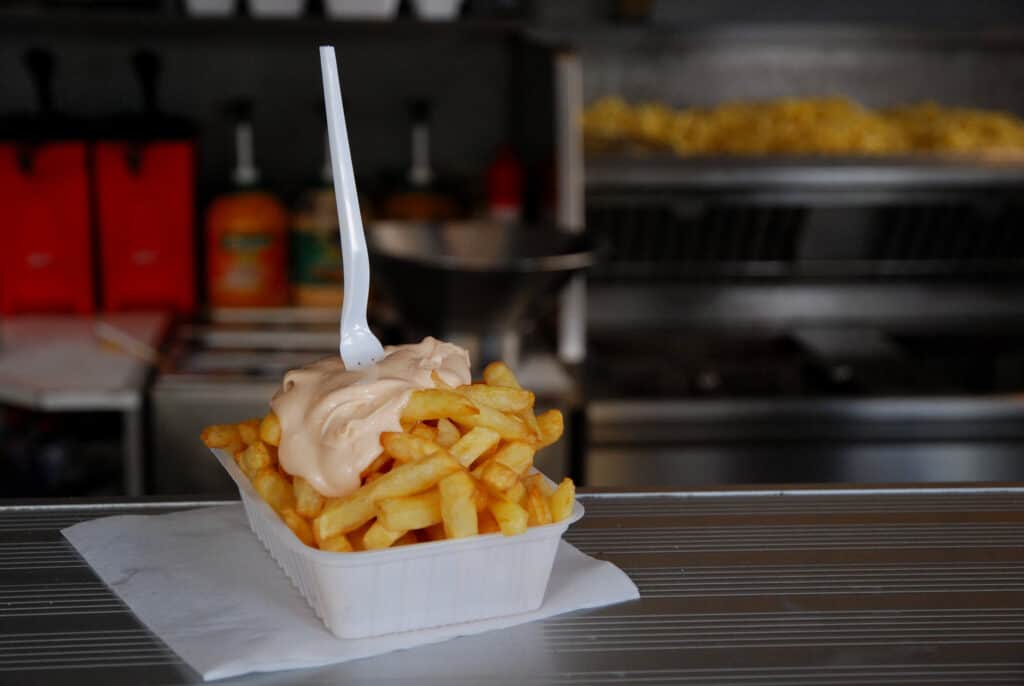
In Belgium, fries are anything but an afterthought, unlike the greasy side dishes you eat alongside your hamburger in other countries. In fact, since the 19th century, they’ve been the star of the show at the frituur — an easy-going eatery selling the perfect tray of potato fries, fried snacks, and sauces.
And that frituur (or fry shop, roughly translated) is an integral part of the Belgian streetscape.
According to Navefri-Unafri, there are more than 4,600 frituurs in Belgium — a country with just over 11 million people. To put that into perspective: that’s almost 10 times as many stands per capita as there are McDonald’s locations per American.
A 2021 VLAM study suggests that 91% of the population agrees that fries are inseparable from Belgian culture. That same study suggests that just about half of us (49%) go to the frituur every month. What’s more: on an average day in 2021, one in ten Belgians ate fries. That’s over one million people eating fries, every day of the year.
Fries are such a vital part of our national food culture that the government supports a yearly initiative called National Fry Week to further spotlight our national pride and joy. In 2022, the week takes place between 7 and 13 November.
While the fry’s origins remain contested, the Belgians have elevated baking fries to a true art form. So what really sets Belgian fries apart from American, British, or — God forbid — French fries?
According to Bernard Lefèvre, the average Belgian fry doesn’t exist.
“We Belgians are too fond of our individuality to make our fries adhere to strict regulations that make them uniform, like in the United States,” says Lefèvre.
“There are regional differences in the thickness of Belgian fries, but anything thinner than 9 mm or thicker than 14 mm is very questionable,” he continues. “The length of the fry, however, fully depends on the length of the potato.”
While there may not be a gold standard — pun intended — there are certain ground rules to making Belgian fries.
They are always lightly salted and double-fried — one pre-fry of 5 to 6 minutes at a lower temperature and a second fry in much hotter oil, just before serving. The double fry makes Belgian fries deeply golden brown, crispy on the outside, and fluffy on the inside.
“The perfect Belgian fry starts with the right potato,” adds Petra De Pauw, author and host of Frietcast — a podcast in which she invites notable Belgians to discuss their fry habits.
“Belgium has the ideal climate to grow potatoes that will eventually make delicious fries. Any Belgian abroad can easily taste the difference.”
The origin of the fried potato may be debated, and the world may continue calling them French fries. But in the end, there’s no Belgium without fries, and there are no fries without Belgium.
Now, if you don’t mind, I’m going to get my weekly fix.
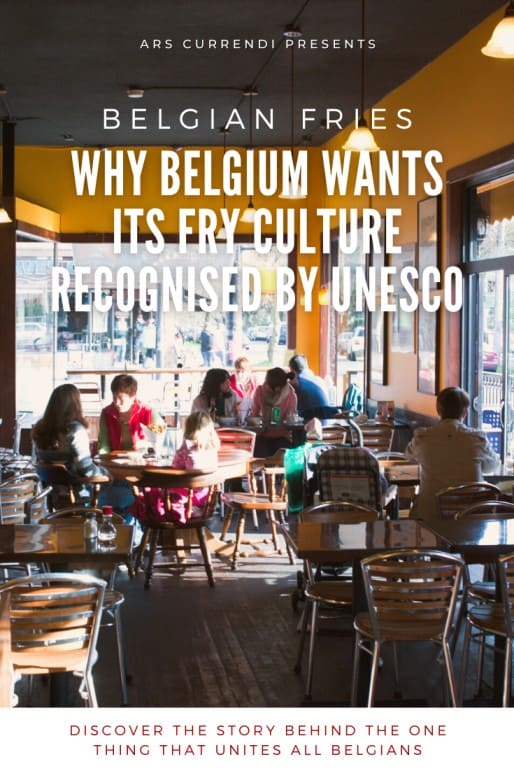
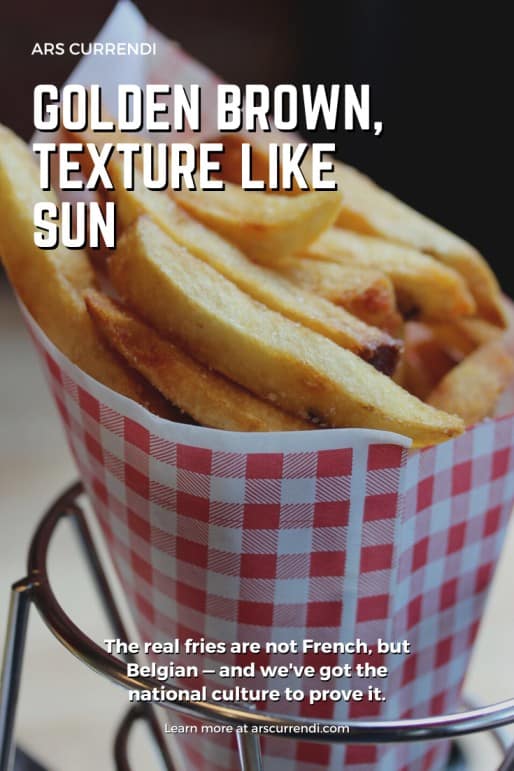
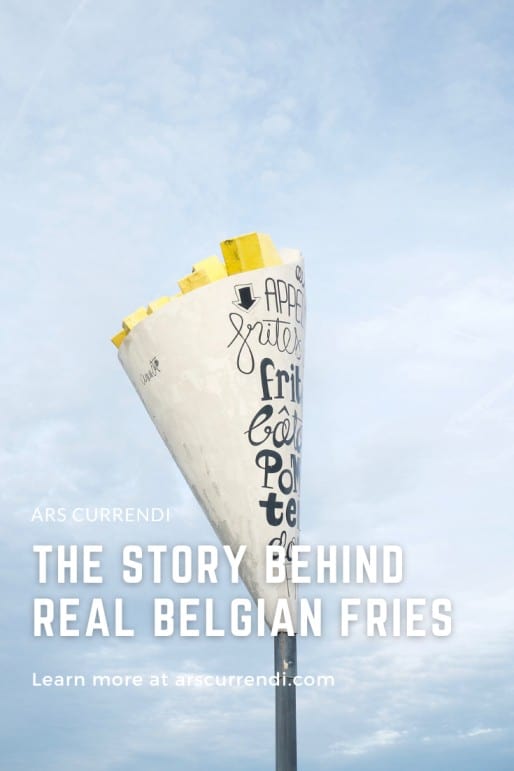
Photo credits
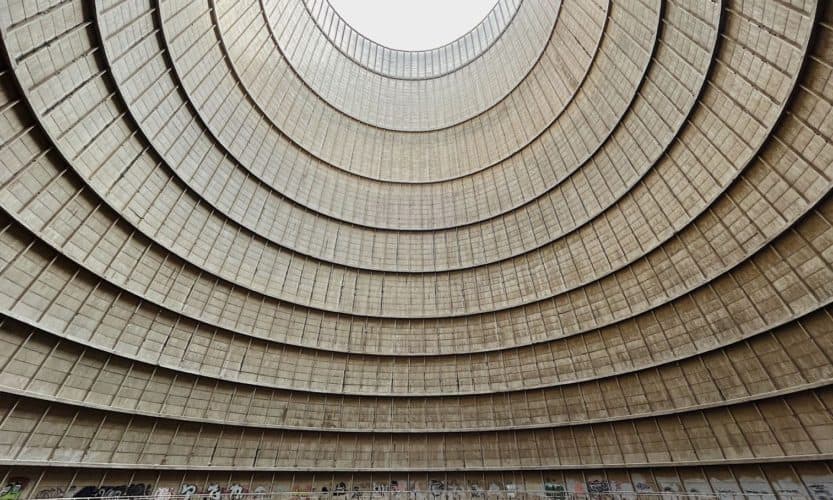
I’ve told people I want to visit Charleroi for over two years. It’s the third-largest city in Belgium and has a rich heritage as an industrial hub. The only problem? A 2008 survey by Dutch newspaper De Volkskrant named it the ugliest city in the world — and even the official Wallonia tourism page agreed.
So what’s the appeal of visiting the ugliest city in the world?
Charleroi is in the centre of a coal basin. In other words, the perfect place for a thriving industrial economy. Steel, iron, glass, and chemical production sites were Charleroi’s bread and butter in the 19th and 20th centuries.
In the 1970s, however, demand for non-renewable energy sources slowly but steadily decreased. Steel mills and factories had to close their doors, making dozens of huge buildings in the area derelict shells of themselves.
A sad story for the city’s already bleak skyline.
And music to urban explorers’ ears.
Related: Why I visited an abandoned children’s hospital in Berlin
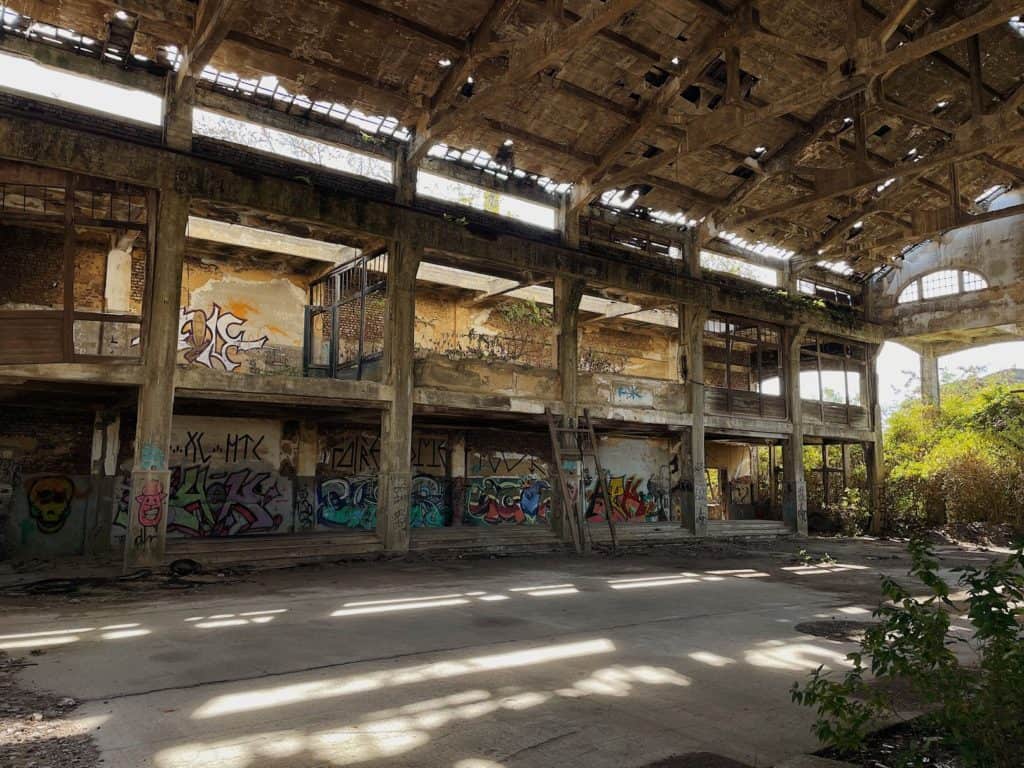
Charleroi amassed significant power thanks to its absolute reliance on the mining and steel industries. That industrial power was fleeting, though. What remains are shadows of the city’s past — stark reminders of the force Charleroi could have become.
Was this change devastating for local companies’ shareholders? Yes.
Does it now give adventurous spirits the chance to discover the city through a 20th-century coal worker’s eyes? Also yes.
For anyone who is not afraid of climbing stone-and-wood constructions that may have been sturdy some time ago or jumping a few metal fences, Charleroi is paradise — hidden in plain sight.
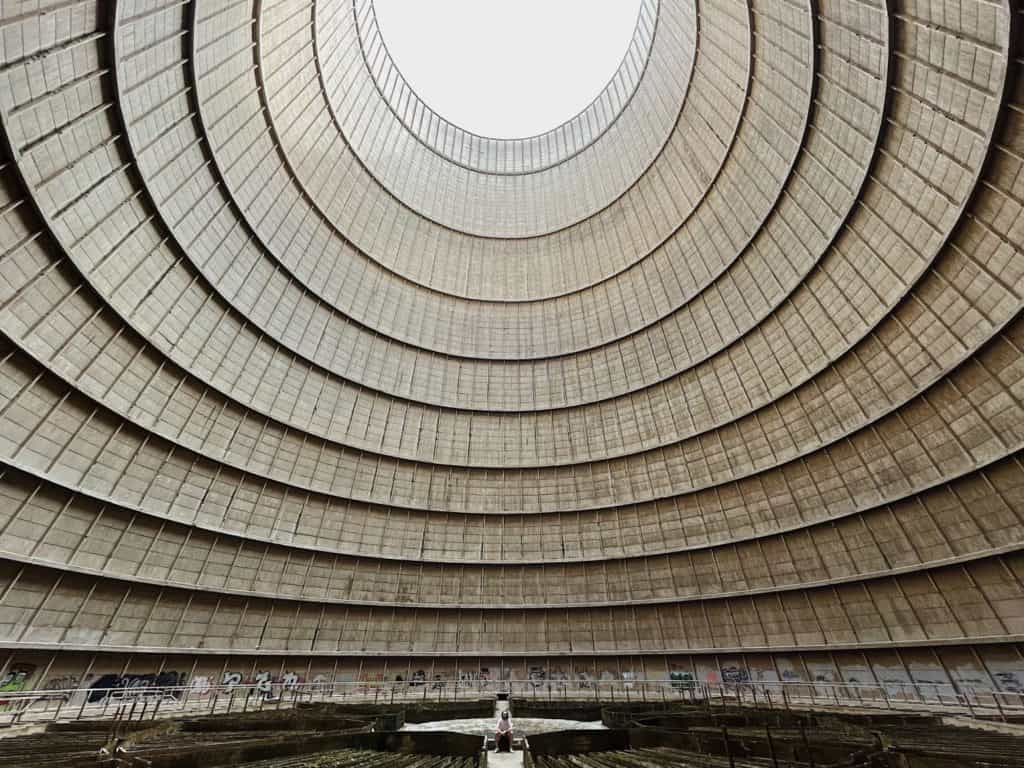
Stop one: an abandoned coal-fired power plant some 6 km outside the city centre. The cooling tower — Power Plant IM — saw the light of day in 1921. It was one of the largest power plants in the country for decades.
But when a 2007 report revealed the plant was responsible for 10% of the total CO2 emissions in Belgium, Greenpeace protests ensued. The structure closed shortly after.
In the following years, several measures were taken to deter people from entering the building. Doors were locked and sealed, staircases were removed, and all known entrances were closed off.
With some thorough investigation, you can still find climbable stone beams — if you’re not afraid of the decaying structural integrity of a 100-year-old building, that is.
If you do end up inside the tower, you’ll see something that could have come straight from a big-budget science fiction flick.
The building has been scheduled for demolition for a few years, but nobody knows exactly when this will take place.
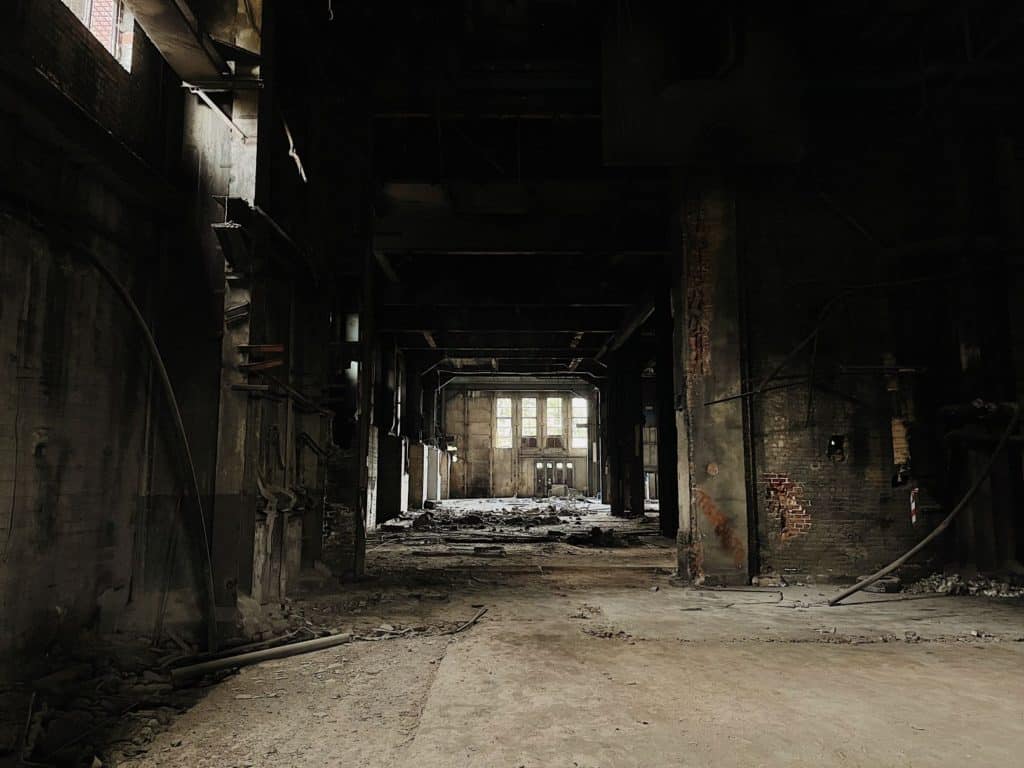
Next stop: the coal factory just across the river Sambre.
This factory was part of the same power plant, which, in its heyday, was one of the most important energy providers in Belgium.
Not much information can be found about this building online except that production came to a halt in 2007 and the facility closed its doors in 2010.
Demolition of this site started in 2014, but most of the plant was still standing in September 2022. An adjacent office building even became an airsoft location for a while.
Over the years, the high glass walls became broken windows and pillagers looted the metal machinery inside. What remains is an impressive skeleton of a building, once again reminding visitors of the city’s forgotten glory.
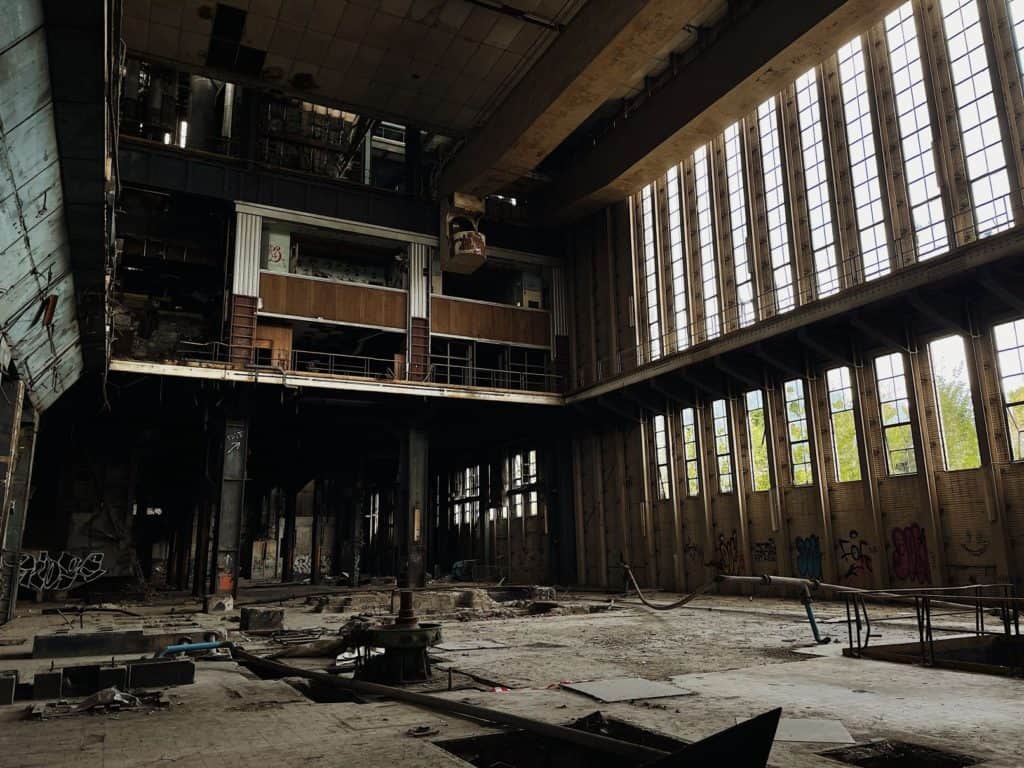
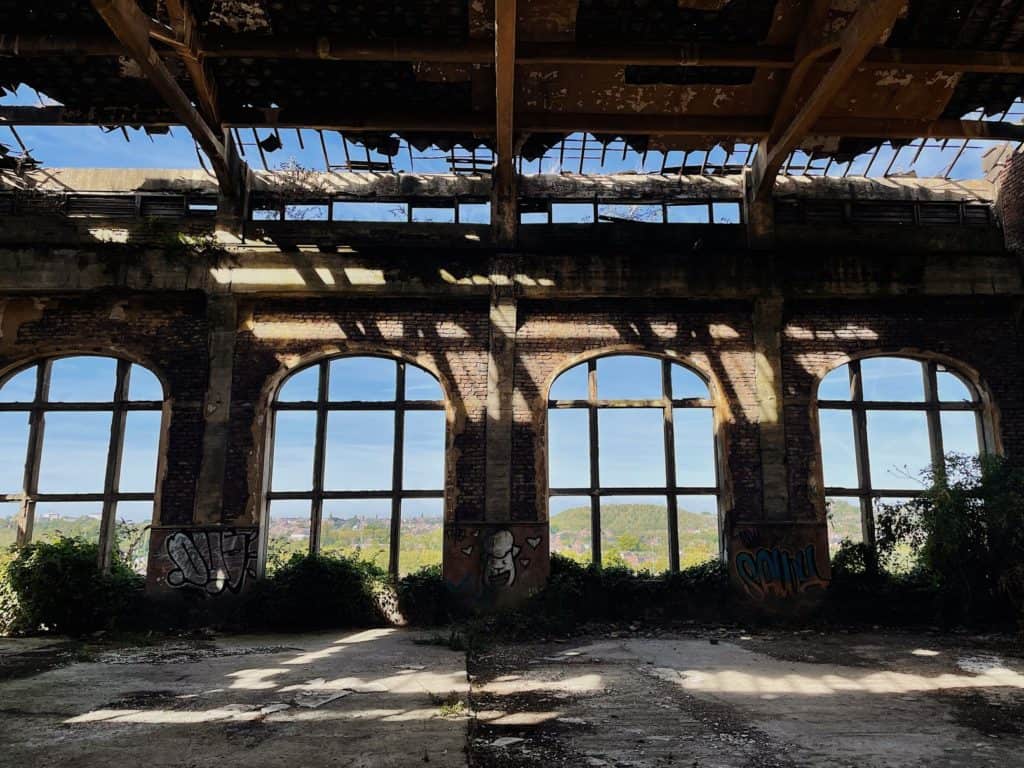
As the steel industry in the south of Belgium grew, demand for coal steadily increased. Dozens of companies inaugurated large factory buildings, storage spaces, and coal mines in and around Charleroi.
One of the leading mining companies in Belgium owned this building. It was the company’s tenth mining well, where around 145,000 tonnes of coal were mined every year.
But the fairy tale soon reached its final page — and it wasn’t a happy ending.
In the spring of 1969, the mine closed its doors. The company ceased operations just a few months later. Since that fateful year, the building has been in the hands of several owners. One of them even wanted to turn it into a zoo.
Spoiler alert: that didn’t happen.
Now, when visiting this site, you’ll notice some ongoing business in the front part of the plant. And no, it’s not ghosts, human traffickers, or drug addicts. A concreting company still uses this part — but the barking dogs and clattering machines are easy to surpass on a dirt path to the left.
In what remains of the city’s industrious history, Mother Nature seems to be reclaiming what’s rightfully hers. Trees are growing from the brick walls, stubborn grass is creeping through the floors, and a bed of soft moss is retaking the central square.
It’s not quite New York City, but … talk about a concrete jungle.
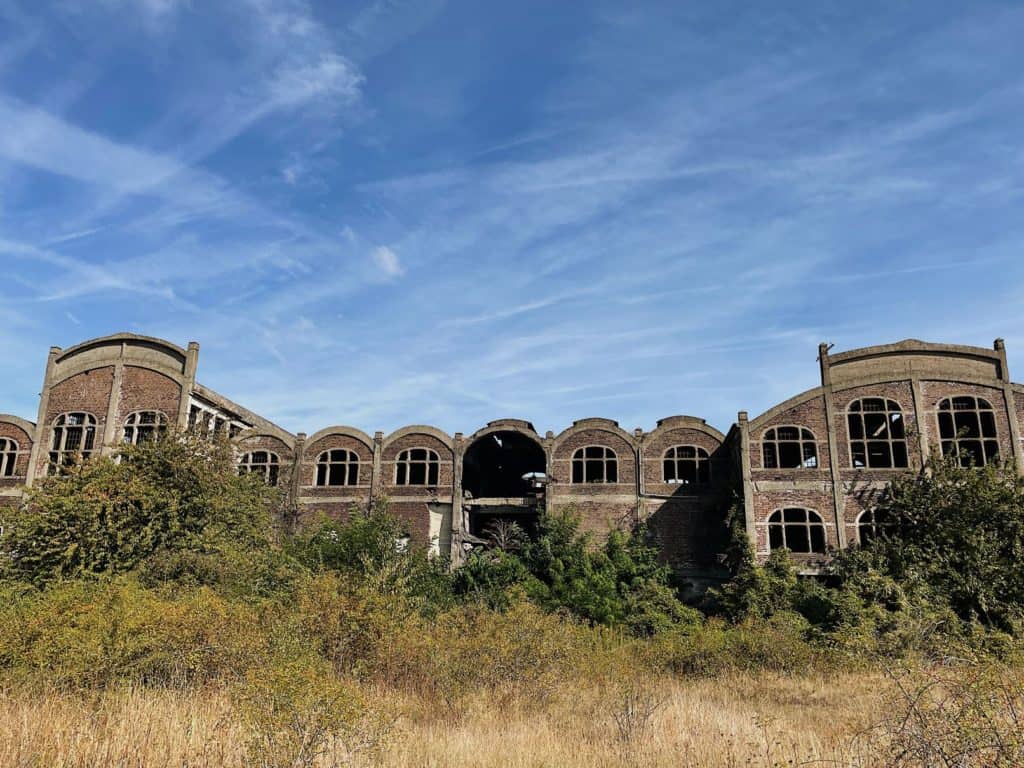
Seeing these buildings devoid of human life — a shell of what they once were — is a humbling reminder of nature’s tremendous power.
We’re only here for a cosmic second, but the forces of nature will remain long after we’re gone.
Keep that in mind the next time you’re worrying about that missed deadline.
Note: I’m deliberately not sharing where you can find these Charleroi urbex locations. They’re easy enough to find with a 5-minute Google search. I’m happy to share more information in a private message, but since urbexing is tolerated at best and downright illegal at worst, I’d rather not risk it.
PIN IT!
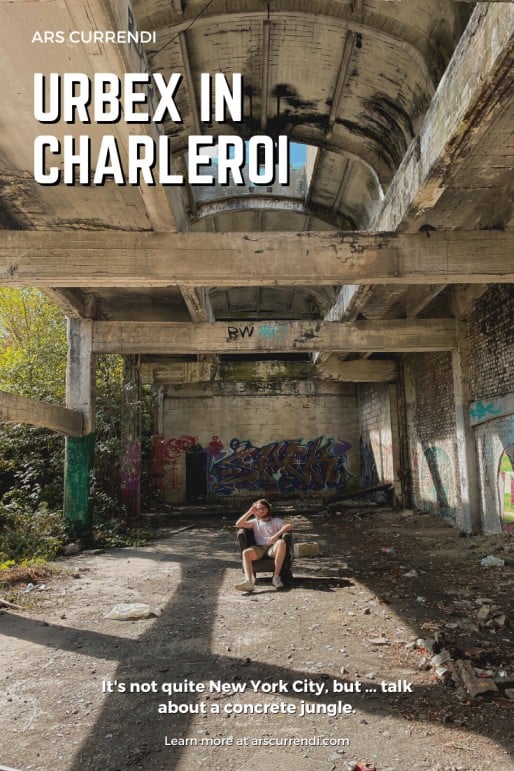
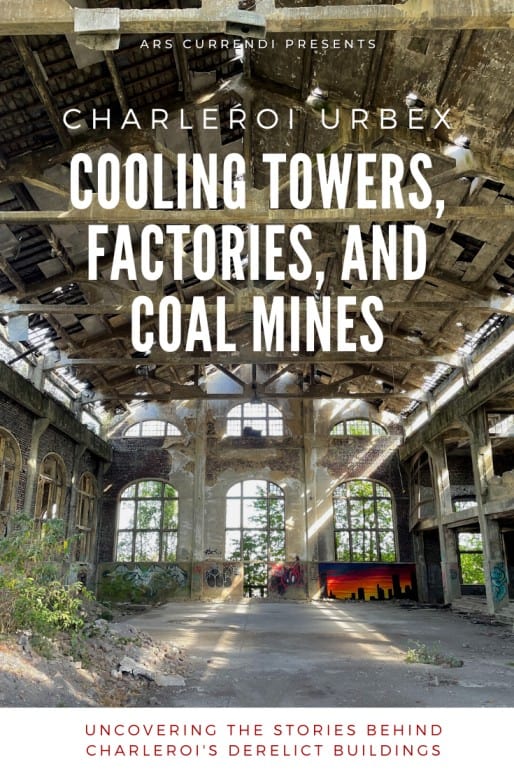
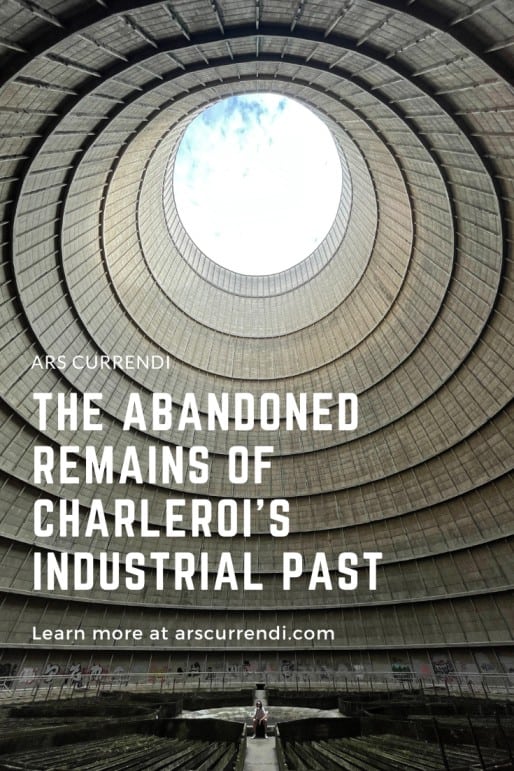
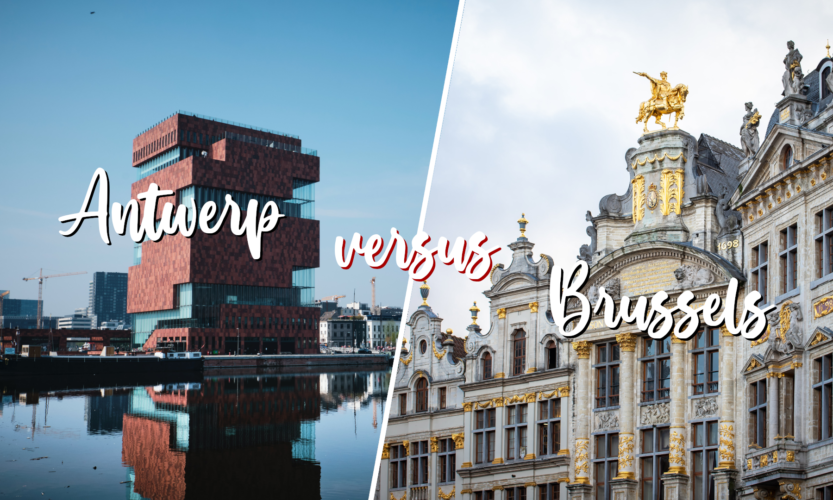
Antwerp vs. Brussels: the battle of the Belgian titans. International travellers in Belgium often find their way to Brussels and Bruges. But you may want to discover whether the Belgian capital is really the best city for you. Today, I’ll tell you all about the two biggest cities in Belgium: Brussels and Antwerp. Which one will you visit?
Skip ahead for specific sections:
If you’re travelling solo, you’ll have a great time in Belgium. It’s safe, there are plenty of things to do, and English is widely spoken around the country.
But if you only have a few days to spend in Belgium, you may be looking for the best places to visit. I personally love big cities, so Antwerp and Brussels are logical choices.
While it’s true that Antwerp is a city less discovered by international travellers, I believe Brussels will give solo travellers more bang for their buck.
The winner: Brussels. The capital is more fit for solo travellers, but Antwerp is a close second for those who want to discover lesser-known cities.
In terms of activities, attractions, and historic sights, I would dare to say that Antwerp and Brussels are an even match. Here’s an overview of the most important things to do in Brussels and Antwerp:
More free things to do in Antwerp:
There’s a reason why so many international travellers flock to Brussels when visiting Belgium. That reason? There are plenty of things to do.
The winner: It’s a tie. The choice between Antwerp and Brussels depends on your personal preference. If you prefer a city with a rich heritage and historical and political importance, go to Brussels. If you prefer a city with a vibrant atmosphere and lively energy, Antwerp is your best bet.
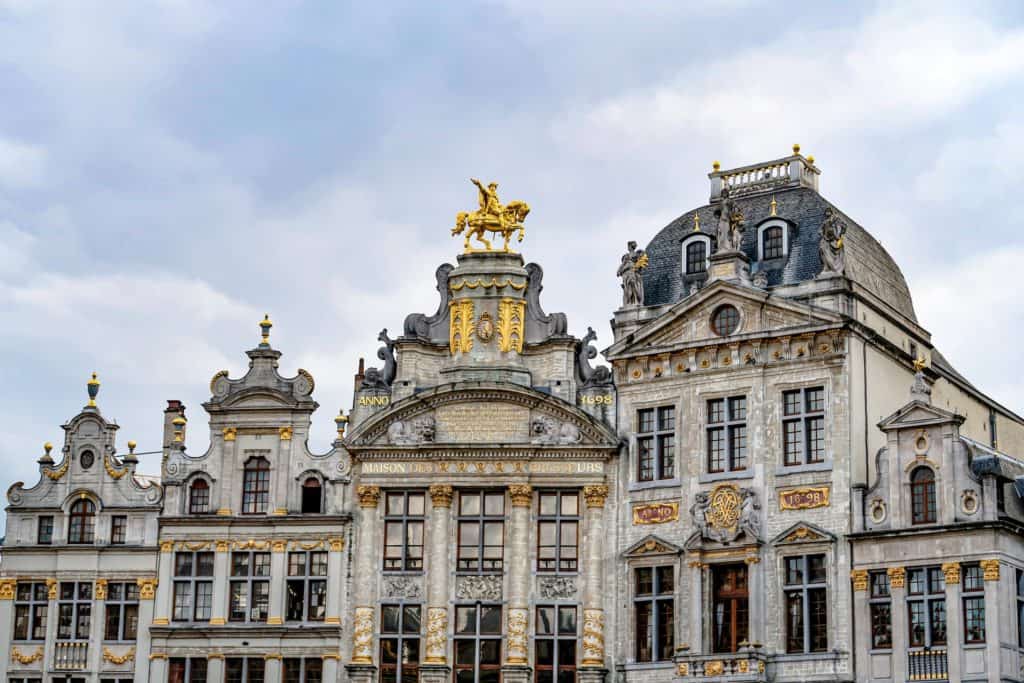
Now, I’m going for a bit of a hot take here: besides a few exceptions, the architecture in Brussels is nothing to write books about.
And before you come at me in the comments mentioning Grand Place, the Atomium, or La Monnaie: I know. I’m not saying you should skip the Belgian capital because of its lack of architectural beauty. All I’m saying is I personally prefer the more modern and eclectic architectural heritage of Antwerp.
The winner: Antwerp.
Belgium may be known for its beer, waffles, and chocolate. But the country’s cuisine has much more to offer to travellers willing to venture beyond the basics.
Here’s a few of my favourite Belgian dishes you may not know:
Whether you want to taste a few of these local delicacies or find the best exotic restaurants in town, both Brussels and Antwerp are stellar choices.
That being said, I live in Antwerp, so I’ve spent much more time here. In other words: I know which restaurants to recommend and which to avoid. Here’s an overview:
The winner: It’s a tie. Both cities have a wide range of excellent restaurants, both for solo travellers and groups of people.
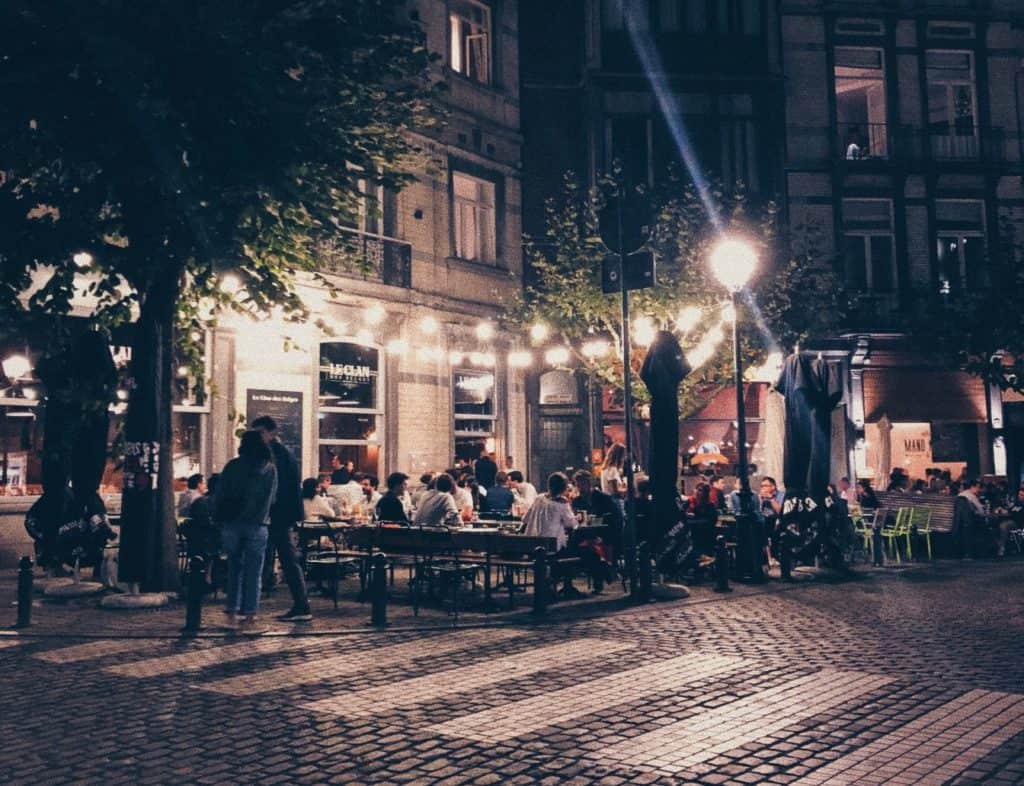
When comparing the nightlife in Antwerp vs. Brussels, it’s necessary to say that both cities can give you an experience you won’t soon forget.
Antwerp boasts an impressive range of vintage cafés, jazz bars, and places where you can have a delicious cocktail or a fresh pint of Belgian ale.
If you’re looking for nightclubs as greasy as they come — in the best way possible — head to one of the following areas:
Unlike Antwerp and other major Belgian cities (like Ghent), the nightlife in Brussels is not concentrated in one central area. The best bars and clubs in Brussels are sprawled around the city, giving people something worth experiencing in every neighbourhood.
Here are a few local favourites:
The winner: Antwerp. I’ve gone out in both cities multiple times, and I generally enjoy the nightlife in Antwerp more than I do in Brussels.
In my personal experience, travellers in Belgium often only find their way to Brussels and Bruges. They don’t usually take the time to discover other Belgian cities, like Antwerp and Ghent.
While this inevitably means that Brussels will be more crowded with fellow travellers, it also means that the capital is more dependent on international tourism than other cities in Belgium — like Antwerp.
In other words: you’re more likely to be greeted rudely, scammed, or ripped off in Brussels — especially if you’re staying in the popular areas of the city around Grand Place.
The winner: Antwerp. If you’re looking for a Belgian city with welcoming, friendly locals, Antwerp is your best bet.
The comparison in cost of living in Antwerp and Brussels is very different for locals and visitors.
It’s true that Brussels is a more expensive city to live in than Antwerp (e.g. rent, utilities, childcare, etc.). However, this is compensated for by higher consumer prices in Antwerp (e.g. groceries, restaurants, activities, etc.).
That being said: you can find plenty of ways to save money in both cities — including free things to do, cheap public transport, affordable accommodation, and more.
The winner: Brussels. If you’re staying in the city for just a few days, Brussels will give you more for the same amount of money than Antwerp.
Let’s add up the points and answer the question, once and for all: “Should I visit Brussels or Antwerp?”
Brussels puts up a hell of a fight, but Antwerp claims victory in this battle of the Belgian cities.
PIN IT!
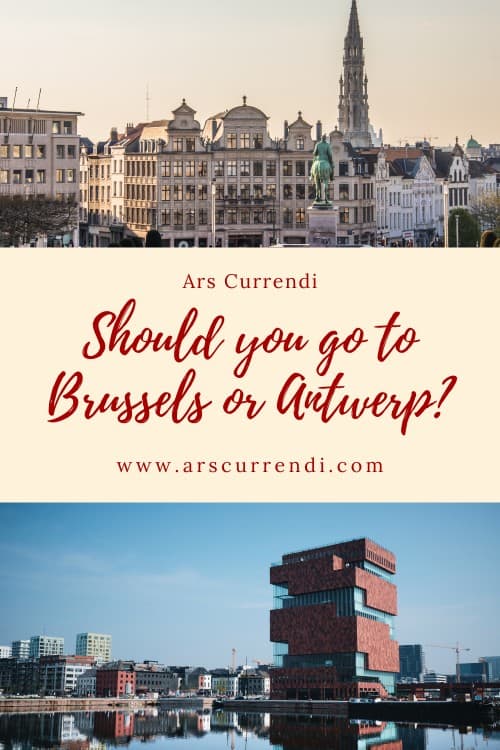
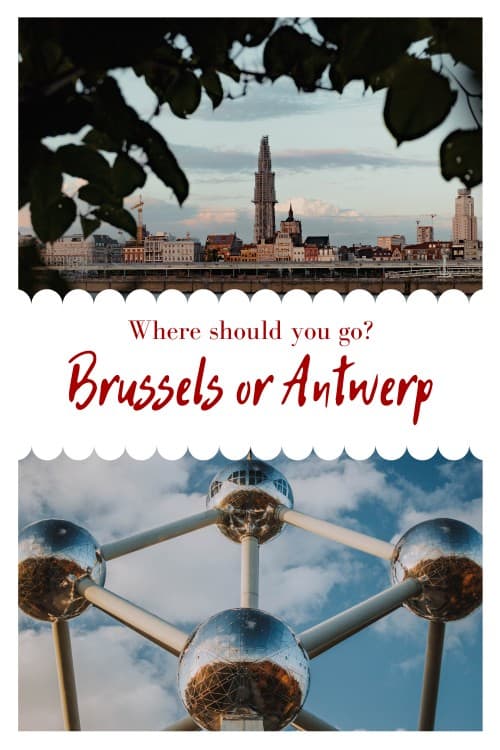
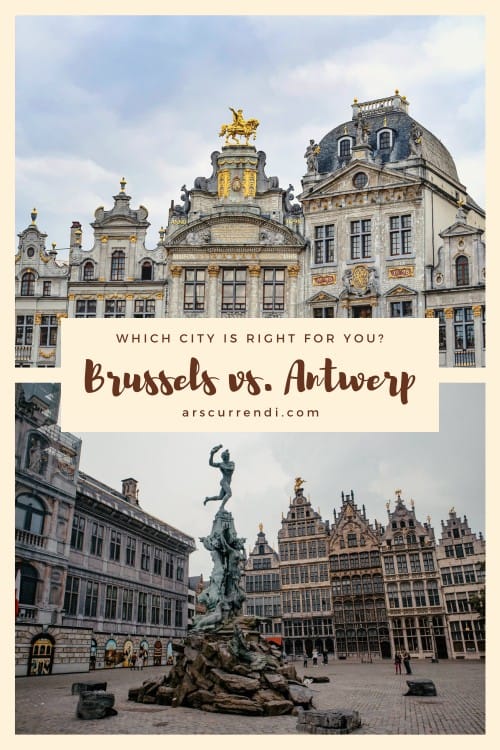
Photo credit:
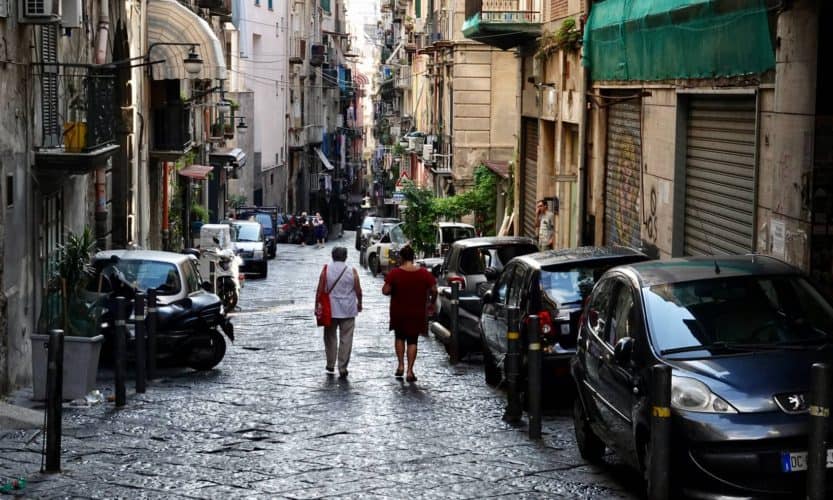
In the middle of a delayed, sweaty, overcrowded train ride from Naples Central Station to the archaeological ruins of Pompeii — somewhere around Torre del Greco — it dawned on me: maybe all the rumours about Naples are true.
It was my girlfriend and I’s first international trip together. After considering our options for a few days, we decided to head to the colourful Amalfi Coast. It looked like a destination that was romantic, relaxing, and reasonably priced. I had rarely been more excited to embark on an adventure.
Until I realised that the easiest way to get from Belgium to Amalfi without a car is flying into Naples.
Now, I had heard stories about Naples. How the city’s trash problem hadn’t been fixed in years. How nearly every building was covered in graffiti (and not the fun kind). And how the public transport was unreliable and inefficient — at best.
You may say Naples is the most unfiltered, gritty version of Italy you can find. And you may even believe that’s a good thing. But I don’t.
If you like Naples, good for you! I’m not trying to get you to dislike the city. It has wonderful places waiting to be discovered, the food is to die for, and the centuries’ worth of history hidden in the city are unfathomable.
All I’m saying is: it’s not a city that immediately enchants everyone.
To a small-town guy like myself, Naples feels a lot like the New York City of southern Europe. You feel like you just have to visit at some point, the place has plenty of things to do, and you need a few days to decompress when you get home.
The only way to find out whether the destination is worth your time is to give it a try.
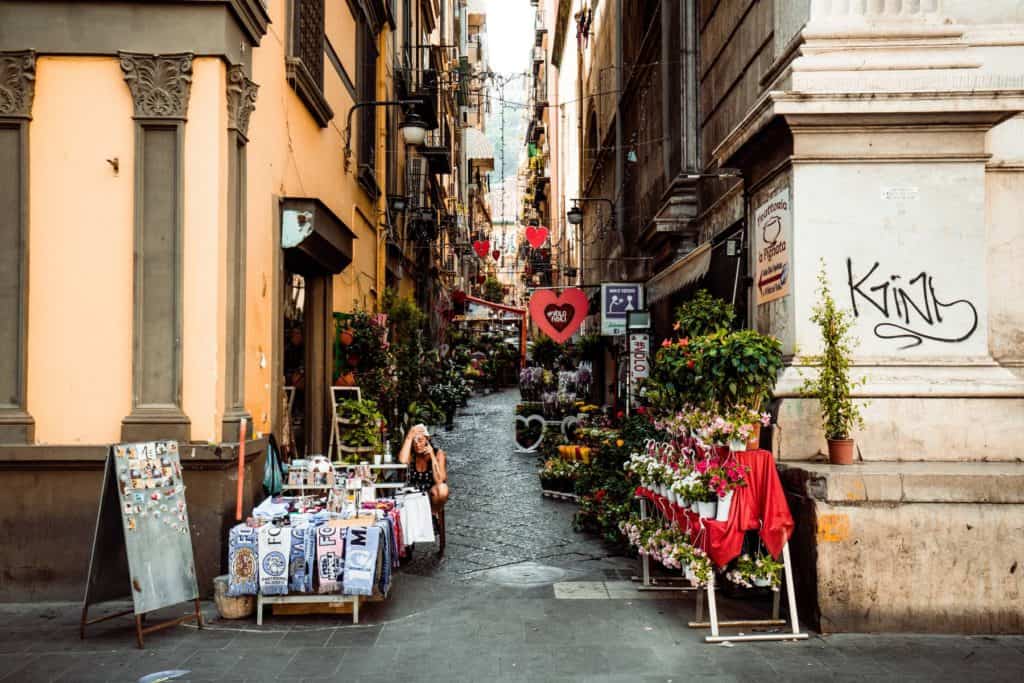
Reading this article may lead you to believe that I hated every minute of my time in Naples. But nothing could be further from the truth. After all, you can’t hate a city you’ve only spent two days in.
We decided to explore Naples before continuing to the Amalfi Coast. We were going to be passing through anyway, so why not slow down a bit and take a gander at the city?
As it turns out, two days was plenty of time to do everything we wanted to do in Naples. In short: walk around, eat and drink to our hearts’ content, and soak in the atmosphere.
One thing I liked about these two days is that we didn’t feel the need to cross off things from a list of “things to do in Naples”. This allowed us to spend quality time together without feeling anxious about missing out on certain experiences.
I’m sure we skipped a few things that would have been worth our time, but I don’t regret any of the decisions we made on this trip. I will look back on our time in Naples and remember the conversations we shared on a rowdy square and the dogs who came to say hi when we were having a drink.
And I wouldn’t have it any other way.
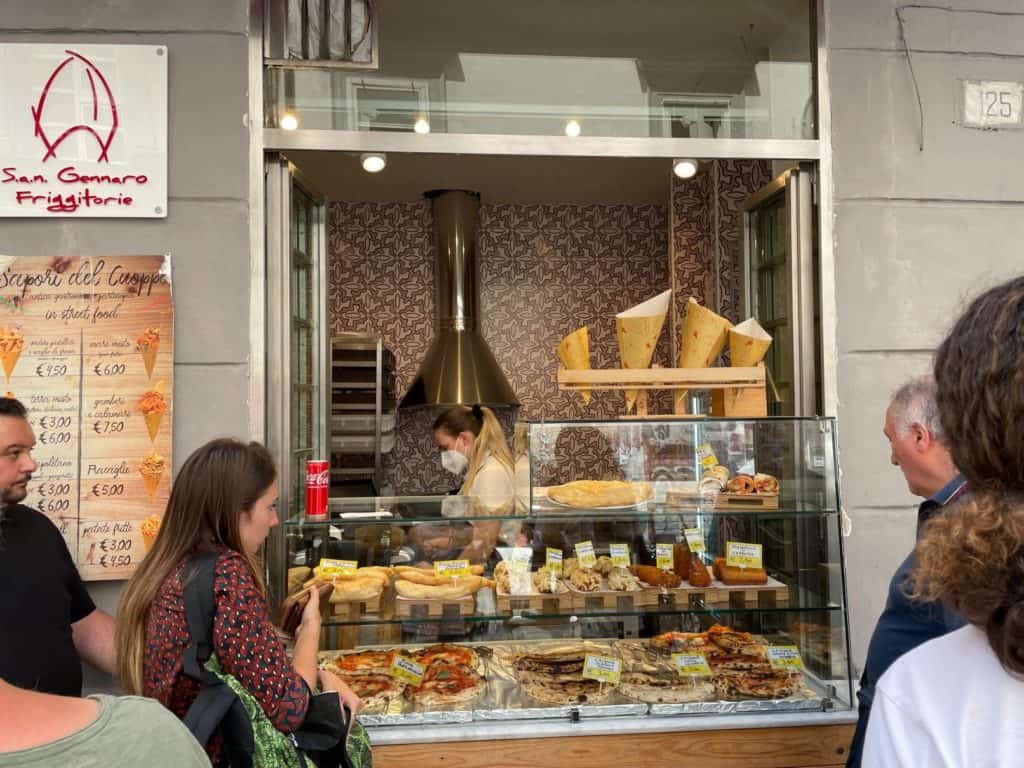
When you’re talking about the literal birthplace of the pizza, you’d better have a good reason for criticising the food.
Don’t get me wrong — some of the food we had in Naples was mouth-watering. We were blown away by the sfogliatelli, arancini, sgagliozze, crocchè, and other food with names that are tricky to pronounce for non-native speakers.
Remarkably, the one thing that disappointed us was the pizza. Maybe it’s because we were only there for two days and we didn’t venture far enough into the lesser-known depths of the city in pursuit of the perfect pizza napolitana. Or maybe it’s because we were anticipating a life-changing meal.
Either way — we expected more from a city known for its pizza.
We were told the best pizzeria in Naples was L’Antica Pizzeria da Michele. So, of course, we were more than happy to wait in line for 15 minutes before a middle-aged Italian man shouted my girlfriend’s name and handed us our dinner in the typical square cardboard boxes.
Again, don’t get me wrong: in terms of value for money, we got a deal that was hard to match. €5 for a pizza we both struggled to finish? Come on.
Could it be that I drew the wrong conclusion from this experience? That Naples does have life-changing pizza — and it’s just a matter of managing expectations?
Maybe Naples is a city that will grow on me with a second visit. Or maybe it’s just not my cup of tea. And you know what? I think that’s okay.
PIN IT!
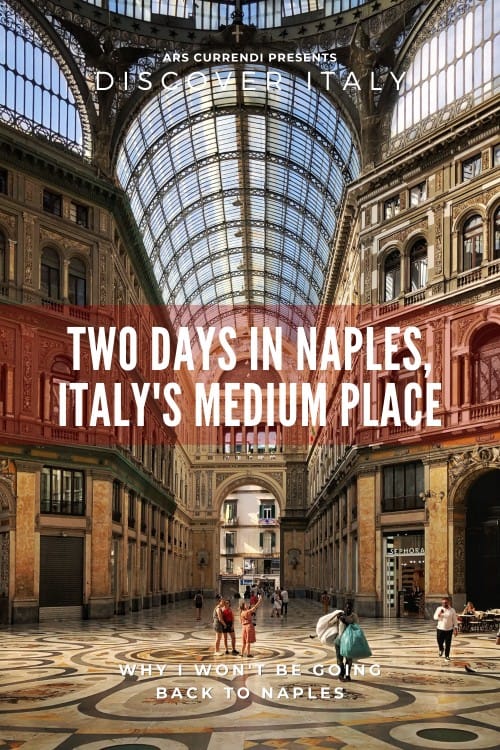
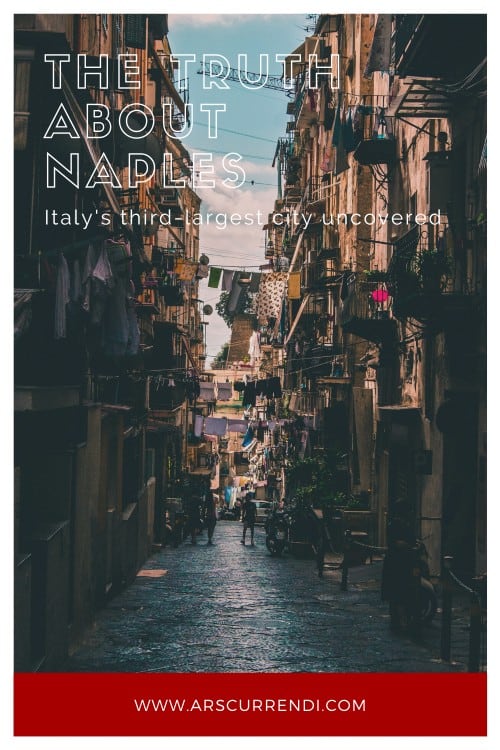
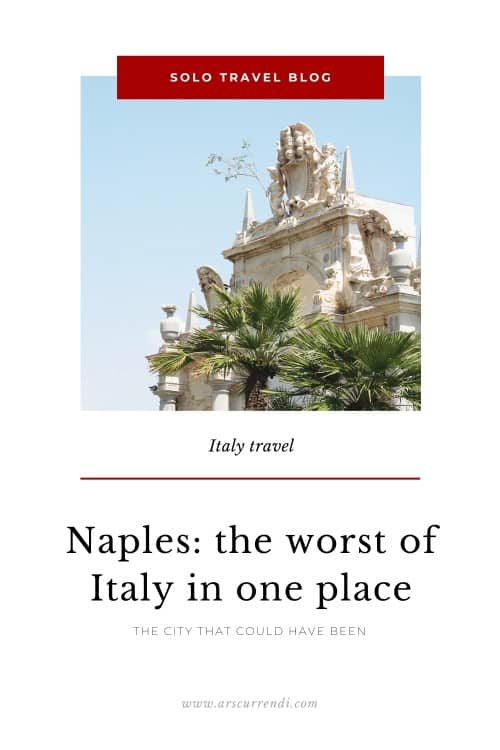
Photo credits
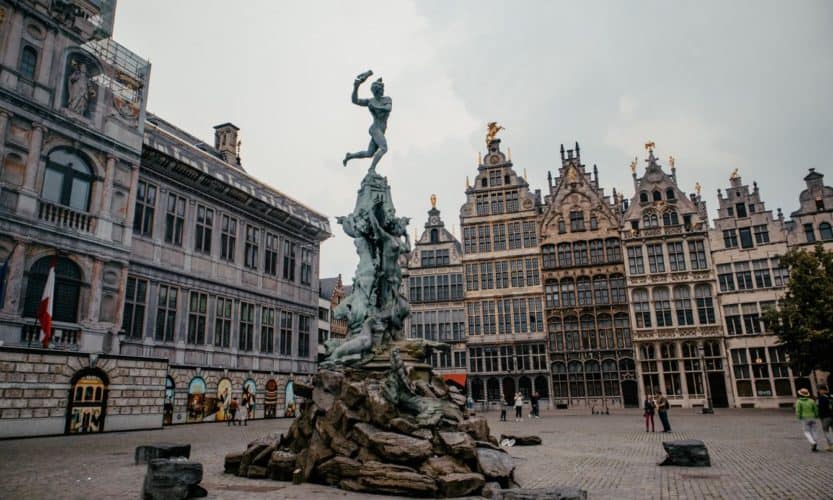
Are you visiting Belgium on a budget? Then you may be looking for the best free things to do in Antwerp. Fear not: a local — yours truly — is here to help. Antwerp is probably my favourite city in Belgium. Granted, I live here, so I may be a bit biased. But still: it’s undeniably an amazing city with great culture, history, nightlife, and restaurants. Are you ready to discover why I recommend visiting Antwerp to all my friends? Let’s jump in!

Before you start booking your train tickets or hostel rooms, there are a few things you should know about travelling to Antwerp.
First and foremost: if you intend to stay in Antwerp for two or more days, get an Antwerp City Card. It might seem a bit pricey, but this card will give you free entry to 16 major museums and plenty of other attractions worth your time. You’ll also get discounts all around the city and free access to public transport.
Buy the Antwerp City Card here.
Secondly: if you’re coming to Antwerp by train — and even if you’re not — don’t forget to admire Antwerp Central Station. It’s often mentioned in “Most beautiful train stations in the world” lists, and for good reason.
Lastly: Antwerp is one of the culinary hotspots in Belgium. Don’t let the extensive list of amazing restaurants in Antwerp pass you by.
Are you a visual learner? You’ll find each of my favourite free things to do in Antwerp on this interactive map.
(Is the map not loading properly? Try this link.)
Whether you’re looking for a new coffee table book, a present for your sister’s birthday, or a fun way to spend a few hours — there are plenty of independent bookstores in Antwerp worth your time.
Some of my personal favourites:
If you’re as much of a literary nerd as I am, you’ll appreciate this article about the best independent bookstores in Antwerp.
Joining a free walking tour is one of the best ways to get to know a city. That’s no different in Antwerp.
Legends Tours organises tours with knowledgeable, English-speaking guides every day at 10:30 AM, 1:30 PM, and 8 PM. They’re rated #1 on TripAdvisor, and for good reason.
If you’re looking to join a tour, just book a spot on their website and come to the Grote Markt at your designated time slot.
After wandering through a narrow, cobbled alley, you’ll find yourself at the beautiful Hendrik Conscienceplein — unsurprisingly named after Flemish 19th-century writer Hendrik Conscience.
This square is home to St. Charles Borromeo Church, which is often called the most important baroque church in the Low Countries.
Thanks to the many cafés and restaurants and the street performers who also frequent the square, it’s one of the locals’ favourite places to hang out on sunny afternoons.
My personal favourite bar around this square is called De Zwaan — just so you know.
Antwerp is not only home to the second-largest seaport in Europe, but it’s also where you’ll find five monumental churches within walking distance.
*: Admission to the Cathedral of Our Lady is €8 (€6 for students and over-60s). Admission to St. Paul’s Church is €5 (€3 for students), but free every first Tuesday of the month. Both churches are free if you have an Antwerp City Card.
Each of these churches has a unique personality and story. And, perhaps more impressively in this day and age, they all still host vibrant Catholic communities.
One of the first things I discovered when I moved to Antwerp was the Kloosterstraat, and I still love it.
Let me explain: this street has the perfect mix of vintage interior stores, trendy boutiques, and impressive art galleries. And, best of all, almost all these shops are open on Sunday.
The vibes are immaculate, and you’ll be sure to find a few gems in the window displays. To this day, heading to this street on the weekend is one of my favourite free things to do in Antwerp.
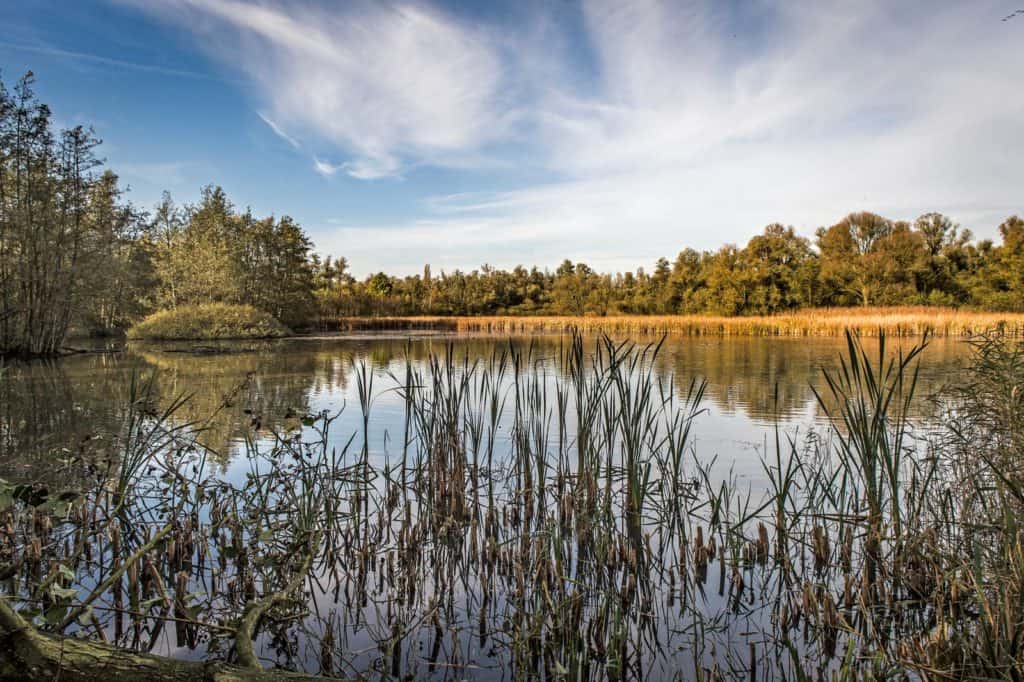
While travelling to the big city — yes, Antwerp is a big city in Belgium — little spots of nature can be a godsend. If you’re looking for a breath of fresh air and some greenery, take a look at the following parks:
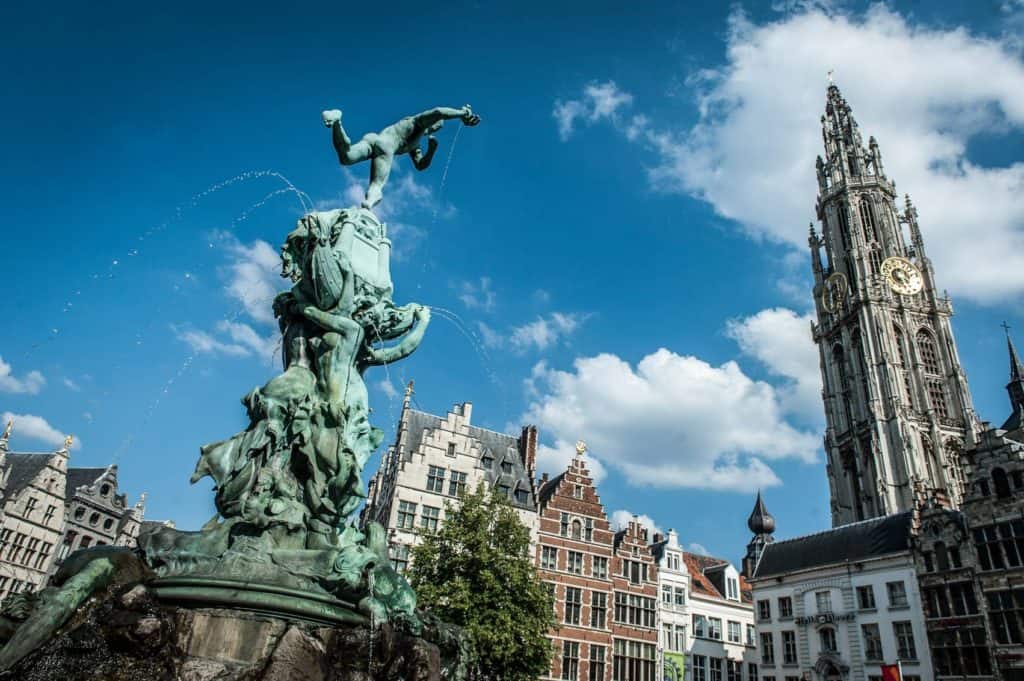
There’s no way you’re travelling to Antwerp without visiting the Antwerp essentials, right? You can cross the following sights off your bucket list in about 30 minutes, so you might as well give them a go.
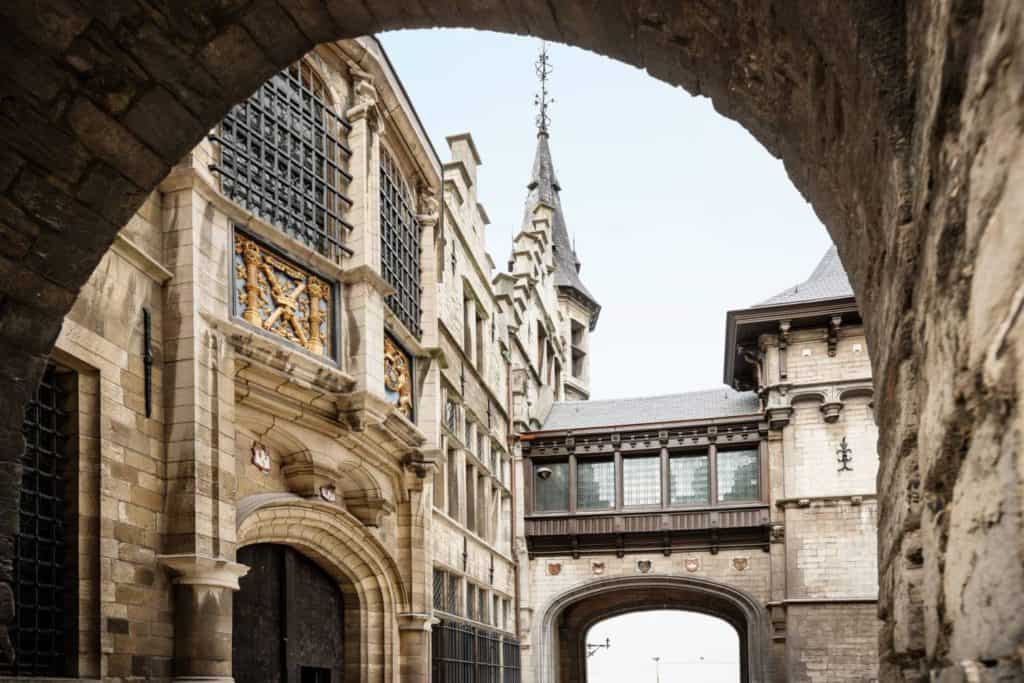
Cities in Belgium and the Netherlands are often said to transport first-time visitors and long-time residents alike back in time.
Whether that’s also the case in Antwerp, you ask? Why don’t you head down to the Beguinage, the Vlaeykensgang, and Het Steen* and find out for yourself? Or discover the secrets that the city’s sewers (also known as De Ruien*) have held since the Middle Ages?
Spoiler alert: it is, in fact, also the case in Antwerp.
*: Het Steen and De Ruien are not free to visit unless you have an Antwerp City Card.
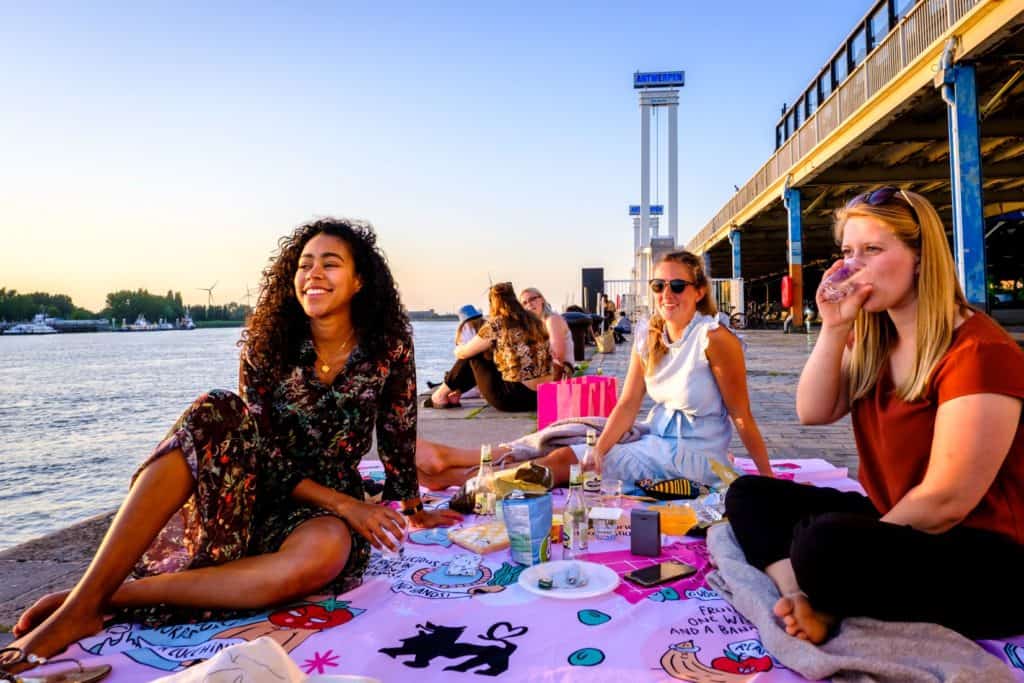
Down by the river, by the boats …
Well, if you’re looking for boats, there are better places to look than the riverside in Antwerp, but there’s still a great time to be had.
Start your afternoon at Het Steen with a walk along the river.
Gather your friends, get some snacks and cheap wine (or a non-alcoholic alternative) at the supermarket, and plump yourself down at the Scheldt Quays. Don’t get up before the sun sets — trust me.
I’ve been living in Antwerp for nine months at the time of writing this. That’s great news for me, because I love living here. But it’s also great for you. After all, I can now tell you all about the best restaurants around the city.
Vegetarian, Italian, Asian, or brunch — whatever you’re looking for, Antwerp has got you covered.
Most of my favourite places to eat and drink are in Het Zuid — the trendy neighbourhood in the south.
Discover the best places to get breakfast, lunch, dinner, and drinks around Antwerp:
When making a top-10 list of free things to do in Antwerp, there are bound to be some things that just don’t make the cut.
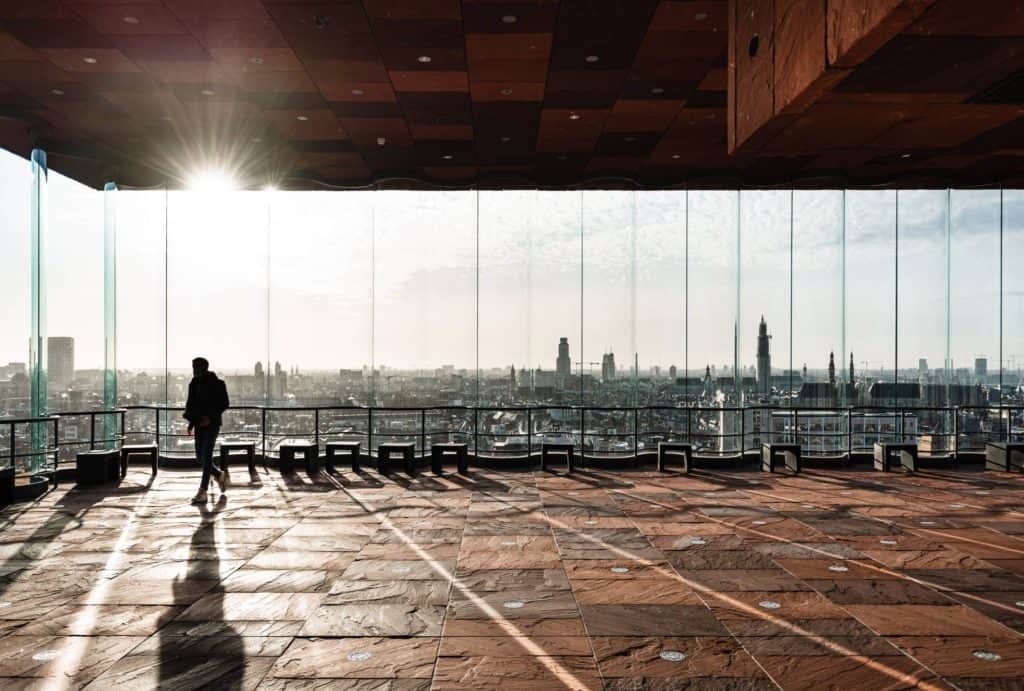
These are my honourable mentions — or, in other words, free things to do in the city if you have some time left over.
These were a few of my favourite free things to do in Antwerp — thanks for reading! Did I miss anything? Be sure to let me know in a comment.
PIN IT!
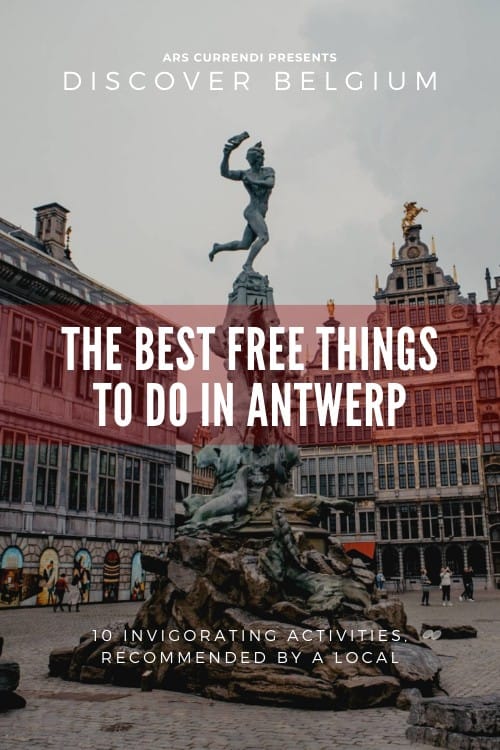
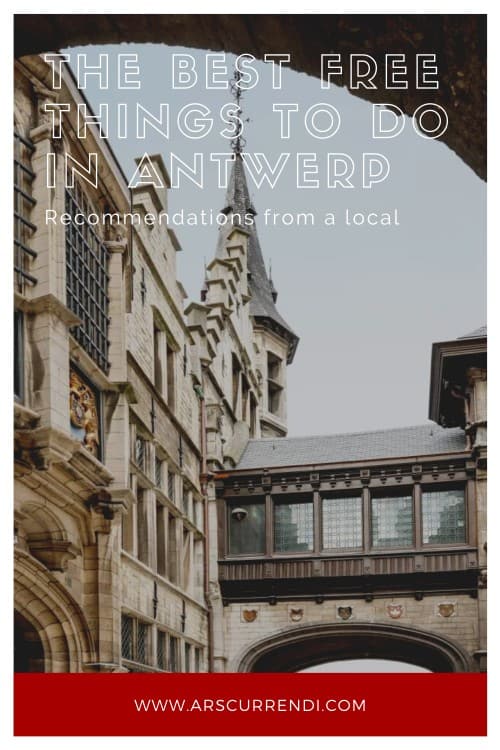
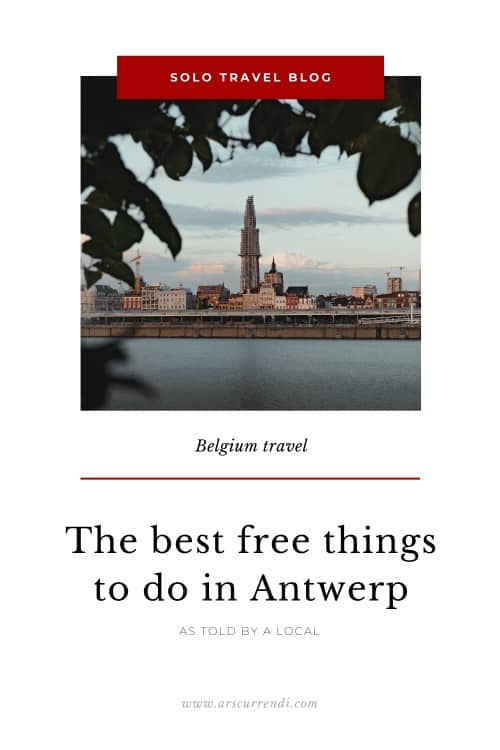
Design by NXNW.